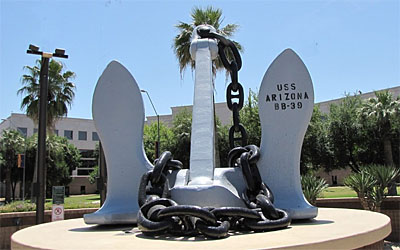On a clear beautiful tropical morning 75 years ago, December 7th 1941, the Japanese Imperial Fleet surprised the U.S. Military in a raid of unprecedented size and for the next 2 hours wave after wave of planes pounded the ships and bases in and around Pearl Harbor.
Japan intended the attack as a preventive action to keep the U.S. Pacific Fleet from interfering with military actions the Empire of Japan planned in Southeast Asia against overseas territories of the United Kingdom, the Netherlands, and the United States. Over the next seven hours there were coordinated Japanese attacks on the U.S.-held Philippines, Guam and Wake Island and on the British Empire in Malaya, Singapore, and Hong Kong.
The attack came as a profound shock to the American people and led directly to the American entry into World War II in both the Pacific and European theaters. The following day, December 8, the United States declared war on Japan. Domestic support for non-interventionism, which had been fading since the Fall of France in 1940, disappeared. Clandestine support of the United Kingdom (e.g., the Neutrality Patrol) was replaced by active alliance. Subsequent operations by the U.S. prompted Nazi Germany and Fascist Italy to declare war on the U.S. on December 11, which was reciprocated by the U.S. the same day.
The attack commenced at 7:48 a.m. Hawaiian Time. The base was attacked by 353 Imperial Japanese fighter planes, bombers, and torpedo planes in two waves, launched from six aircraft carriers. All eight U.S. Navy battleships were damaged, with four sunk. All but the USS Arizona (BB-39) were later raised, and six were returned to service and went on to fight in the war. The Japanese also sank or damaged three cruisers, three destroyers, an anti-aircraft training ship, and one minelayer. 188 U.S. aircraft were destroyed; 2,403 Americans were killed and 1,178 others were wounded. Important base installations such as the power station, shipyard, maintenance, and fuel and torpedo storage facilities, as well as the submarine piers and headquarters building (also home of the intelligence section) were not attacked. Japanese losses were light: 29 aircraft and five midget submarines lost, and 64 servicemen killed. One Japanese sailor, Kazuo Sakamaki, was captured.
Remembering this day is very meaningful to the state of Arizona.
Let Greens Keeper Landscape Maintenance do all the work for you and take the burden off your shoulders all together. Give us a call at 623-848-8277 and let’s talk about it.
Presented by:
Greens Keeper Landscape Maintenance, LLC
623-848-8277
http://www.commerciallandscapecare.com
greenskeeperllc@cox.net


No comments:
Post a Comment
Note: Only a member of this blog may post a comment.